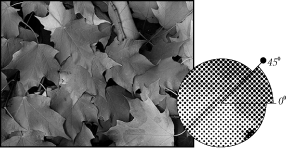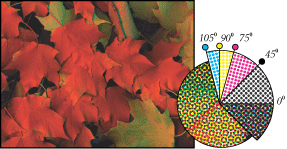Selecting halftone screen attributes
Halftone screen attributes include the screen frequency and dot shape for each screen used in the printing process. For color separations, you must also specify an angle for each of the color screens. Setting the screens at different angles ensures that the dots placed by the four screens blend to look like continuous color and do not produce moiré patterns.
Halftone screens consist of dots that control how much ink is deposited at a specific location on-press. Varying their size and density creates the illusion of variations of gray or continuous color. For a process color image, four halftone screens are used: cyan, magenta, yellow, and black--one for each ink used in the printing process.


In traditional print production, a halftone is produced by placing a halftone screen between a piece of film and the image and then exposing the film. In Photoshop, you specify the halftone screen attributes just before producing the film or paper output. For best results, your output device (a PostScript imagesetter, for example) should be set to the correct density limit, and your processor should be properly calibrated; otherwise, results can be unpredictable.
Before creating your halftone screens, check with your print shop for preferred frequency, angle, and dot settings. (Use the default angle settings unless your print shop specifies changes.)
To define the screen attributes:
- Choose File > Print with Preview.
- Select Show More Options, choose Output from the pop-up menu, and click Screen.
- In the Halftone Screens dialog box, choose whether to generate your own screen settings:
- Deselect Use Printer's Default Screens to choose your own screen settings.
- Select Use Printer's Default Screens to use the default halftone screen built into the printer. Photoshop then ignores the specifications in the Halftone Screens dialog box when it generates the halftone screens.
- For a grayscale halftone, enter a screen frequency from 1 to 999.999, and choose a unit of measurement. Enter a screen angle from -180 to +180 degrees.
- For a color separation, choose from the following options:
- To manually enter the screen frequency and angle, choose a color of the screen for Ink, and enter the frequency and angle; repeat for each color separation.
- To have Adobe Photoshop determine and enter the best frequencies and angles for each screen, click Auto. In the Auto Screens dialog box, enter the resolution of the output device and the screen frequency you intend to use, and click OK. Photoshop enters the values in the Halftone Screens dialog box. Changing these values may result in moiré patterns.
- If you are using a PostScript Level 2 (or higher) printer or an imagesetter equipped with an Emerald controller, make sure that the Use Accurate Screens option is selected in the Auto Screens dialog box (or in the Halftone Screens dialog box if you're entering the values manually). The Use Accurate Screens option lets the program access the correct angles and halftone screen frequencies for high-resolution output. If your output device is not a PostScript Level 2 (or higher) printer or is not equipped with an Emerald controller, this option has no effect.
- For Shape, choose the dot shape you want. If you want all four screens to have the same dot shape, select Use Same Shape For All Inks.
- Click OK.
Choosing Custom from the Shape menu displays the Custom Spot Function dialog box. You can define your own dot shapes by entering PostScript commands--useful for printing with nonstandard halftone algorithms. For information about using PostScript language commands, see the PostScript Language Reference published by Addison-Wesley, or consult the imagesetter's manufacturer.
For optimal output on a PostScript printer, the image resolution should be 1.5 to 2 times the halftone screen frequency. If the resolution is more than 2.5 times the screen frequency, an alert message appears. (See About image size and resolution.) If you are printing line art or printing to a non-PostScript printer, see your printer documentation for the appropriate image resolutions to use.
To save halftone screen settings:
In the Halftone Screens dialog box, click Save. Choose a location for the saved settings, enter a filename, and click Save.
![]() To save the new settings as the default, hold down Alt (Windows) or Option (Mac OS), and click the --> Default button.
To save the new settings as the default, hold down Alt (Windows) or Option (Mac OS), and click the --> Default button.
To load halftone screen settings:
In the Halftone Screens dialog box, click Load. Locate and select the settings, and click Load.
![]() To return to the original default settings, hold down Alt (Windows) or Option (Mac OS), and click <--Default.
To return to the original default settings, hold down Alt (Windows) or Option (Mac OS), and click <--Default.